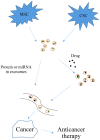Role of stem cell-derived exosomes in cancer
- PMID: 28521391
- PMCID: PMC5431232
- DOI: 10.3892/ol.2017.5824
Role of stem cell-derived exosomes in cancer
Abstract
Exosomes are small, extracellular membrane- enclosed vesicles that contain a variety of molecules, including proteins, DNA, mRNA and non-coding RNA; these vesicles have been defined as new tools for intercellular communication between cells. Numerous types of cells, including stem cells, secrete exosomes into the extracellular environment, and are significant communicators in the tumor microenvironment. Stem cells are a unique cell population defined by their ability to indefinitely self-renew, differentiate into a variety of cell lines, and form clonal cell populations. Stem cells also secrete large amounts of exosomes, which have demonstrated great potential in a variety of diseases. Increasing evidence has revealed that the mechanism of interaction between stem cells and human tumor cells involves the exchange of biological material through exosomes. In this review, the latest developments in the role of stem cell-derived exosomes in cancer are highlighted.
Keywords: angiogenesis; biomarker; cancer stem cell; exosomes; extracellular vesicles; mesenchymal stem cell; metastasis; multivesicular bodies; stem cell; therapy; tumor growth.
Figures


References
LinkOut - more resources
Full Text Sources
Other Literature Sources
